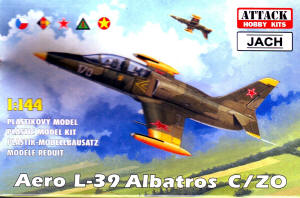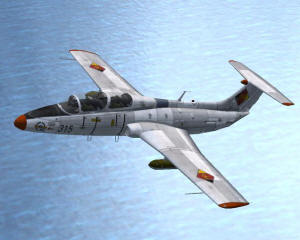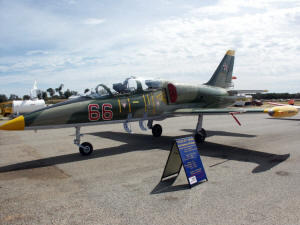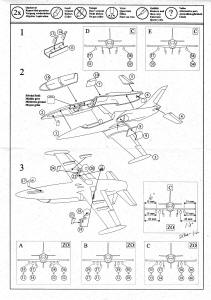|
Attack Hobby Kits 1/144 Aero L-39 Albatros C/ZO |
|
Kit Number 14406 |
|
Reviewed By Jim Pearsall, #2209 |
|
|
|
MSRP: $9.98 USD
Thanks to Attack for this review kit. The Aircraft: The USSR seemed to be unable to design a really good jet trainer. What the Soviets wound up using for a long time were 2-seat versions of obsolete service aircraft, like the MiG-15UTI. I have read that the MiG-15 was a real bear to fly, as it didnít have power assisted controls, so horsing the stick back and forth and pushing those pedals was a chore only for the most physically fit. In the 1960s the Warsaw Pact opened a competition for a new jet trainer. The Czechs offered the L-29 Delfin. |
|
It was assessed against the Yakovlev Yak-30 and the PZL TS-11 Iskra, but
the Delfin was the winner everywhere except Poland, which continued with
Iskra production. In the late 60s, the Aero bureau came up with a sleeker, faster trainer with a turbofan engine to replace the L-29. This was the L-39, which is flown at airshows today in the US. |
|
This aircraft is the L-39ZO, the attack trainer. Rather like our AT-38 or
A-37, except the ZO doesnít carry a gun, just under-wing stores, such as
rocket pods, Atoll AAMs, or fuel tanks. There is a ZA subtype, which
has a 23-mm gun pod with 150 rounds. The Kit: Since itís 1/144, everything is ďpetiteĒ. Get good glasses or a magnifier. Outline of the wing and fuselage match drawings, although there just arenít any 1/144 L-39 drawings to work from. Markings are provided for Czechoslovakia, East Germany, USSR, Iraq and Vietnam. The good stuff: Everything is injection molded. Flash free, very very fine recessed panel lines. No resin, no vacuum formed, no photo-etch. Nevertheless, this is very much a ďstate of the artĒ kit for the scale. The interior (YES thereís an interior!) consists only of a floor with side consoles and the 2 seats. But this compares favorably with the other 1/144 scale kits Iíve built and checked from both Attack and other manufacturers. The seats are more than just blobs, but actually have the big headrests found on modern ejection seats. The spot where there could be an instrument panel is flat, and if you are really into this, you could either hand paint or produce a decal. But since the canopy is a little on the thick side, I didnít bother. The wing is one piece, and the mold designers at Attack have once again done a credible job of making my life easier. The single point where the wing attaches to the sprue is completely hidden by the fuselage when assembled. No need to get out the file, sandpaper, and putty to fix multiple spots in the leading and trailing edges where you had to cut the wing off the tree. The other stuff: There are a couple of fit issues where the wing and fuselage meet, and the fuselage halves didnít line up perfectly for me. Your experience here may be different. Nevertheless, it didnít require much putty to get everything lined up and smooth. |
|
The intakes required a little work, but I applaud Attack for actually
putting the splitter plates as separate parts. The lack of any locating bumps, pins, holes or slots for the horizontal stabilizers, weapons, pylons, and gear doors make this kit one for an experienced modeler, along with its really small parts. |
| The instructions are clear and easy to follow as to the placement of parts and how they fit. The 2 steps are in an exploded drawing, with armament or stores placement around the edges. |
|
I think thereís an error in the instructions. They want you to place the
outer wing store 15 mm from the wingtip. Thatís fine, but then they
want the inner one 45 mm in. The model is only 65mm wide, so that puts
it 20 mm from the other wingtip. About where itís supposed to be, I
guess, but confusing.
Finishing: I decided to do this kit in the markings of the Soviet Air Force (VVS), as I had done the old 1/72 KP kit in these markings when it came out about 20 years ago. I have to say it compares quite favorably with the KP kit, even if itís only ľ the size. I painted the aircraft with Testors Model Masterģ paints. I used OD for the brownish green, and SAC bomber tan for the greenish brown, with WW2 Soviet blue for the underside. The yellow trainer markings are from one of the small Testors bottles. The decals are nicely printed, came off the sheet well, and pretty much went and stayed where I wanted them. I had to use a magnifier to see and align these small markings. |
| Overall: A really nice kit. This is the second 1/144 Attack aircraft kit Iíve built, and they just keep getting better. Theyíve chosen an aircraft which is not run-of-the-mill, but one which has been used by a lot of air forces, and is on the air show circuit today. |
| Thanks again to Attack for producing an interesting and nicely done petite kit. Thanks to John Noack for feeding my modeling Jones again. |
|
Information, images, and all other items placed electronically on this site are the intellectual property of IPMS/USA ģ. |



